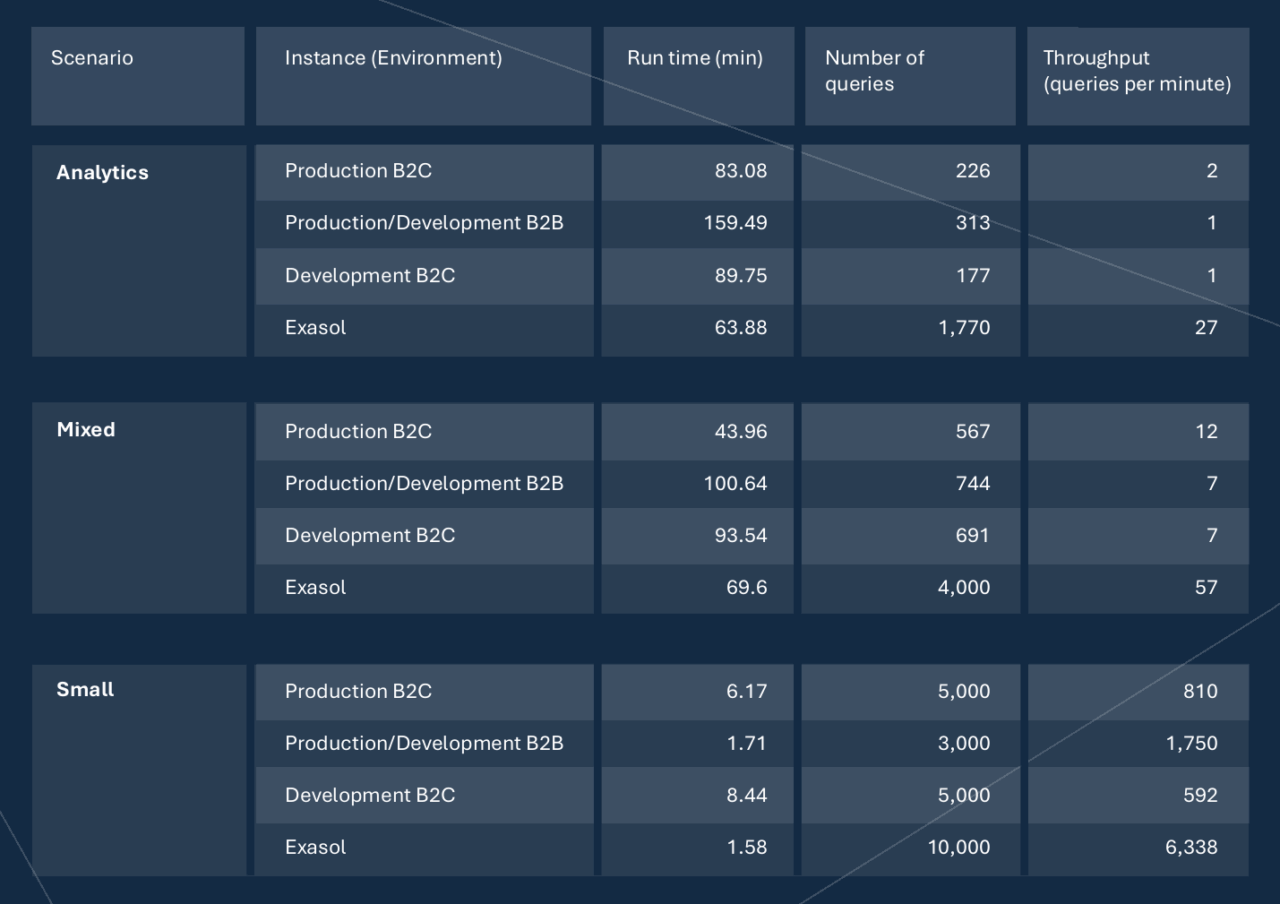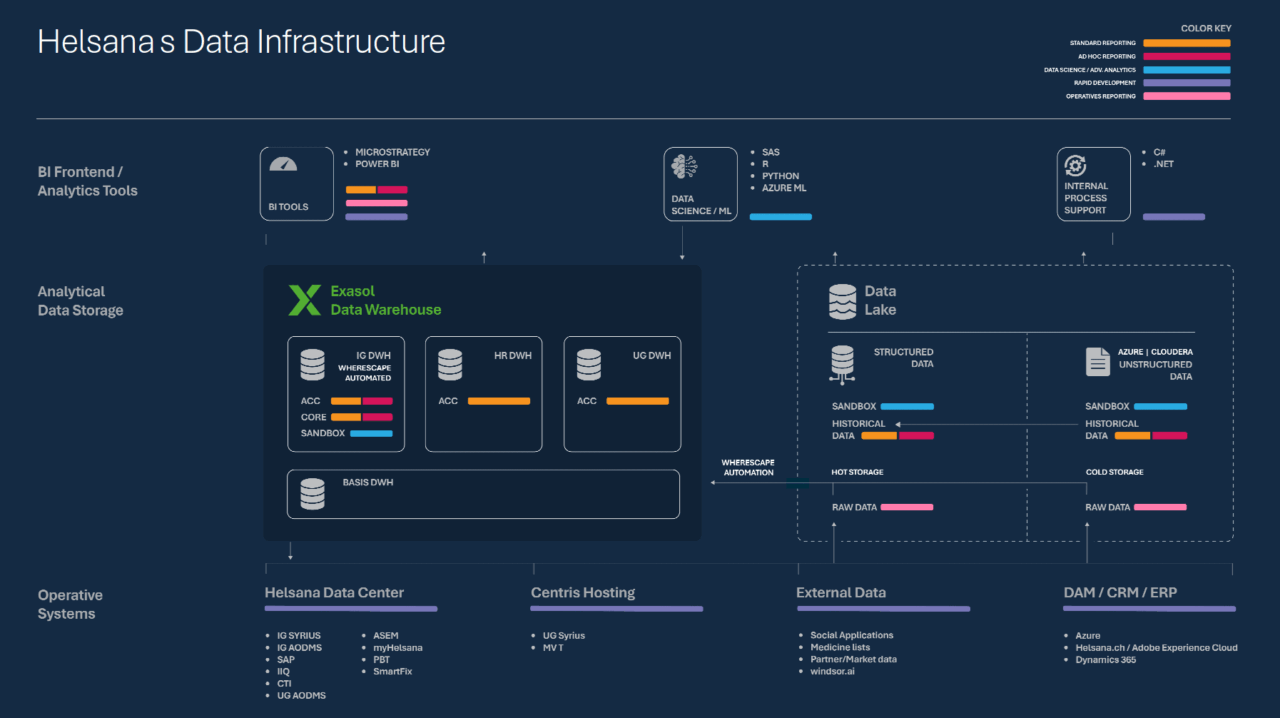Customer Story

Apotek 1 New
Discover how Apotek 1, Norway’s leading pharmacy chain, transformed its data analytics with Exasol Espresso, enabling faster insights, improved operational efficiency, and data-driven decision-making.

The transition to Exasol delivered significant business impact, exceeding the capabilities of the previous legacy platform. It now serves over 600 users with self-service reports and dashboards. The benefits delivered by Exasol include:
Exasol delivered 5-10x faster performance compared to the previous platform, significantly reducing query and dashboard loading times. Users reported real-time responses and eliminated waiting times.
In its first year the transformation reduced Helsana’s license and maintenance fees by 65%. Similarly, implementing the old data warehouse took two years and required 17 external consultants, but thanks to Exasol’s streamlined architecture, Helsana’s migration used far fewer internal resources and was completed within a year, significantly reducing their operational costs.
The speed advantage of Exasol made the system more available, enabling frequent data warehouse updates. Weekly (and even daily) data warehouse updates became possible, compared to the previous quarterly cycle. In production, data warehouse load times shrunk from 26 to 4 hours, with the warehouse handling 4 to 10 times more concurrent queries depending on complexity. Additionally, in-house ETL jobs now execute within minutes, compared to half a day.
Exasol serves as the central repository and high-performance engine for Helsana’s AI use cases, especially those working with structured data, to conduct deeper exploratory analysis.
With over 2 million customers and 7.8 billion CHF in annual premiums, Helsana is a leader in Switzerland’s competitive healthcare industry. Serving roughly a quarter of the Swiss population with over 3,000 employees across diverse business areas, Helsana’s operations are both diverse and complex, demanding a data-driven approach. Despite its size and experience, Helsana’s outdated data infrastructure hampered their ability to make data-driven decisions and posed a significant hurdle to agility.
Switzerland
3,000+
Healthcare
Exasol

Helsana’s disparate business units relied on various reporting tools, with data warehouses built on different technologies and ETL tools, each with its own set of rules and logic. This tangled architecture was inefficient, unfit for purpose and prevented them from achieving the agility they needed to operate competitively.
To tackle the issue and make its data management less complex, Helsana decided to consolidate its fragmented data and analytics infrastructure onto a single platform that was underpinned by consistent standards, centralized governance, and metadata
driven automation. This transformation aimed to reduce complexity, streamline operations, and slash license and maintenance costs. Additionally, automation was key to achieving operational efficiency at scale. The new environment demanded automated development, testing, and deployment to guarantee that data was available during business hours and to make it easier to implement new requirements with minimal downtime.

Helsana completes their critical batch workloads such as end-of-day, weekend and month-end jobs) before a stringent cutoff point at 8am on Mondays. During major releases, they undergo complete data reloads to reflect the new core system structure, and this involves deleting all existing data, implementing the new structure, and conducting a full data reload. To meet these sizable reload demands reliably within tight operational windows, Helsana relies on the performance, scalability and stability of Exasol.

The overwhelming success of the POC solidified Exasol’s position as the foundation of Helsana’s data strategy. They adopted Exasol as their standard data warehouse platform and standardized on WhereScape for ETL and data modeling automation. Additionally, they transitioned from Qlik and Cognos to MicroStrategy for self-service standard reports and dashboards, minimizing the need for manual SQL queries.
As shown on the next page, Helsana decided to migrate part of its hybrid data lake to Exasol because Exasol’s proven speed, low maintenance, and stability made it the natural choice. The migration began in 2023 and aimed to reduce redundant data loading by centralizing everything within a single 80 TB environment.
Currently, nearly all lake queries use Exasol structured data. This approach facilitates low-latency access to essential on-premises systems, and in parallel to this, Helsana is transitioning their unstructured data to a streamlined Azure architecture.


Helsana has clearly defined the purpose of each data platform to optimize their technology stack. The data warehouse, powered by an Exasol and MicroStrategy foundation, serves their predefined business queries and reporting needs. Dynamic SQL generation enables activities like simulating the impact of price changes on customer segments by tapping pre-defined data models. However, new hypotheses – such as analyzing clickstream patterns alongside CRM and KPIs – requires experimentation without an impact on the performance of the production warehouse.
This means that data either resides permanently in the data lake or moves selectively into the Exasol data warehouse, depending on use case parameters. Exasol Virtual Schemas (an abstraction layer that makes external data sources accessible through SQL commands) also provide a bridge between both data environments, eliminating unnecessary data duplication.

Helsana is on a company-wide AI journey because it believes that AI can significantly enhance efficiencies, help automate business processes, and transform internal workflows and client interactions, enabling staff to focus on higher value tasks. Exasol is central to this AI journey because it serves as the repository for the structured data that Helsana uses across all of its AI models, providing the foundation for their analytics.
Looking ahead, Helsana is exploring a proof of value with Exasol, together with Veezoo and Microstrategy to explore their new AI capabilities for data visualization and reporting. This aligns with their vision of democratizing access to data insights, and they anticipate a significant shift in how business data is used, with traditional reports potentially becoming less prevalent. Instead, business users can pose questions in a conversational way using natural, everyday language, and receive rapid, refined results directly through a reporting and dashboarding platform, such as Veezoo or MicroStrategy. This transformation promises quicker, more efficient responses to queries, empowering business users with self-service and freeing up data analysts for more strategic tasks.

From AI to DWH, we’ve got you covered.